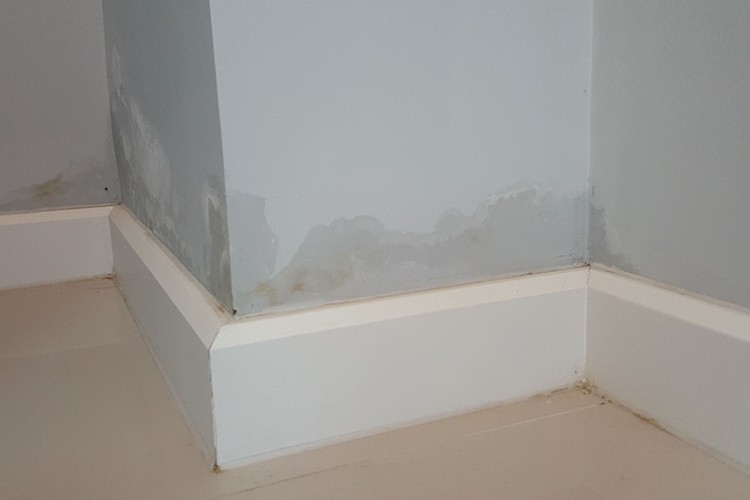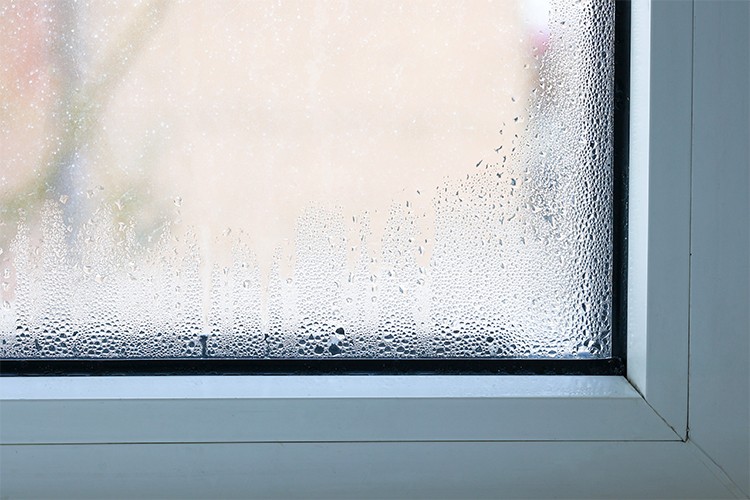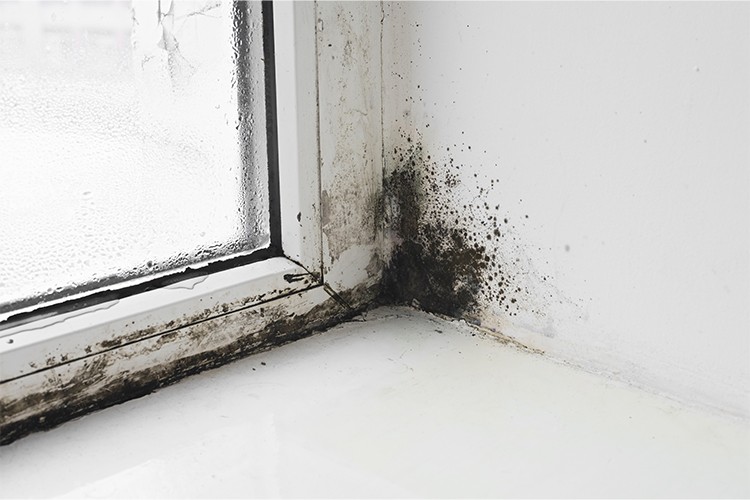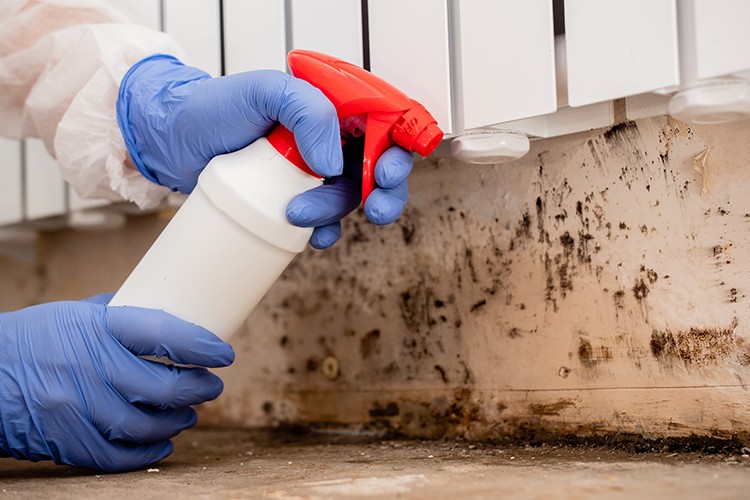Damp, mould and condensation are pervasive issues affecting countless homes and properties across the UK. Whether it’s unsightly black mould or rising damp, such problems put your home and could even put your health at risk if not dealt with correctly.
This comprehensive guide to mould, damp and condensation combines expert advice with all the data and research you need for a full understanding of the problems at hand, as well as how to fix them.
What Is Damp?
Damp refers to the presence of excessive moisture or water within a building's structure, leading to visible or invisible forms of wetness or humidity. Damp can manifest in various ways, such as patches on walls, ceilings, or floors, and can lead to mould growth.
There are three primary types of dampness: rising damp, penetrating damp, and condensation.
Rising Damp
Rising damp is, as the name suggests, damp that rises up through a wall or floor. This type of damp is most common in older buildings or in areas with high groundwater levels. Poor drainage is another contributing factor to rising damp.
Thomas Goodwin, property and construction expert from MyJobQuote, explains why modern homes are less prone to rising damp: “Walls will naturally allow a little bit of water in; however, this usually doesn’t cause damage due to a damp-proof course or a damp-proof membrane. Modern homes tend to have damp-proof courses and damp-proof membranes built in.”

Penetrating Damp
Penetrating damp is the result of water seeping through walls and ceilings, primarily caused by structural issues within the building. Cracks, roof or gutter problems, and internal issues such as leaks from pipes are common contributors to this type of damp.
Penetrating damp is more common in older buildings because they typically lack wall cavities, which newer constructions usually have in order to protect against damp.

Condensation
Condensation occurs when warm, moist air settles onto cold surfaces. It tends to be most prevalent in areas where lots of steam is produced, for example in spaces such as the kitchen and bathroom. It’s recommended to have a good quality extractor fan in your kitchen and bathroom to prevent condensation building up.
You should also keep on top of condensation by wiping it away regularly. If condensation is left in your home for too long, it can damage the paint and plaster on your walls, could lead to mould growth, as well as cause your window and door frames to decay.
Take care with central heating in your home, as this can also contribute to condensation damp issues. As the central heating system warms up and cools down again, warm, damp air is left to settle on the walls. Keeping your home well-ventilated can help to mitigate this issue.

Which UK cities are searching for damp the most?
Top cities where condensation is searched on Google per 10,000 people.
Leeds
- Total searches: 6,300
- Total searches per 10,000 people: 119
Edinburgh
- Total searches: 4,980
- Total searches per 10,000 people: 90
Bristol
- Total searches: 5,490
- Total searches per 10,000 people: 78
Swansea
- Total searches: 2,340
- Total searches per 10,000 people: 74
Milton Keynes
- Total searches: 1,940
- Total searches per 10,000 people: 72
Bradford
- Total searches: 2,610
- Total searches per 10,000 people: 70
Coventry
- Total searches: 2,920
- Total searches per 10,000 people: 66
Brighton
- Total searches: 1,770
- Total searches per 10,000 people: 64
London
- Total searches: 59,860
- Total searches per 10,000 people: 62
Liverpool
- Total searches: 5,650
- Total searches per 10,000 people: 62
Google search data shows that Leeds is the UK city with the most condensation damp, seeing 119 searches per 10,000 people; significantly more than Edinburgh and Bristol, who fall behind in the second and third spots.
How to spot damp and condensation in your home
Here’s how to spot different types of damp around your home.
Rising damp
To identify rising damp, look out for:
-
Tide marks ascending on the wall
-
Peeling paint and wallpaper, often accompanied by wet patches
-
Lifting of floor coverings
-
Damage to plaster and skirting boards
-
A white, powdery substance on walls due to dissolved soluble salt particles
Pentrating damp
Signs of penetrating damp may appear as:
-
Damp patches on walls and ceiling that may intensify in darkness when it rains
-
Staining and discolouration on walls or ceilings
-
Blistering or bubbling of paint or wallpaper
Condensation
Look out for the following indicators of condensation issues:
- Water droplets forming on walls or windows
- Dark mould formations, particularly around windows or on glass surfaces
- Unpleasant musty odours indicative of mould presence
How much does it cost to have damp professionally removed?
Thomas Goodman, property and construction expert, says: “The average cost to damp proof your home usually falls around £300-£2500. However, the overall cost that you can expect to pay will depend on a number of factors including the size of your home and your location.”
How to prevent damp
There are several steps you can take to prevent damp from building up in your home.
-
Reduce bathroom moisture: Prevent bathroom moisture by keeping the door closed during baths or showers. Keep your bathroom ventilated by opening windows and turning on your extractor fan.
-
Use a dehumidifier: Dehumidifiers remove excess moisture in the air, reducing the issue of damp in your home.
-
Wipe down your windows: Take a few minutes every day to wipe your windows and remove any condensation that has gathered.
-
Control steam when cooking: Keep pans covered when cooking to minimise how much steam escapes into the room. Using an extractor fan will also prevent steam in your kitchen, and it helps to keep the kitchen door closed to prevent steam escaping into the rest of the house.
-
Ventilate your home well: Opening your windows for 15 minutes in the morning can increase airflow around your home. If possible, keeping your windows slightly ajar will also help with battling damp and condensation.
What is mould?
Mould is a type of fungus that thrives in dark and damp environments. If left untreated, mould can cause serious health problems, as well as structural damage to your home.

What are the different types of mould?
There are many different types of mould, and they are usually categorised by colour.
Most Googled mould colours in the UK:
Black mould
- UK search volume: 263,040
White mould
- UK search volume: 35,440
Green mould
- UK search volume: 9,480
Brown mould
- UK search volume: 5,730
Yellow mould
- UK search volume: 4,670
Blue mould
- UK search volume: 3,040
Grey mould
- UK search volume: 2,680
Google search data shows that Brits are most concerned about black mould, with a whopping 263,040 searches per year. That’s over four times the number of searches for all the other types of mould combined.
Brits are searching for black mould for good reason; Stachybotrys Chartarum, a type of black mould, is known to be one of the world’s Top 10 Most Hazardous Fungi. This type of mould requires very wet or high humid conditions lasting days or weeks to grow. However, not all black mould is Stachybotrys Chartarum, so it’s best to check with an expert for a diagnosis first.
Top 10 cities with the most searches for black mould
Leeds comes out on top with the most searches for black mould per 10,000 people. Edinburgh and Brighton follow, whereas Milton Keynes and Sheffield have considerably fewer searches for black mould each year.
Leeds
- Total searches: 3,710
- Total searches per 10,000 people: 70
Edinburgh
- Total searches: 3,330
- Total searches per 10,000 people: 60
Brighton
- Total searches: 1,540
- Total searches per 10,000 people: 56
Bristol
- Total searches: 3,690
- Total searches per 10,000 people: 52
London
- Total searches: 46,400
- Total searches per 10,000 people: 48
Swansea
- Total searches: 1,210
- Total searches per 10,000 people: 38
Liverpool
- Total searches: 3,200
- Total searches per 10,000 people: 35
Coventry
- Total searches: 1,340
- Total searches per 10,000 people: 30
Milton Keynes
- Total searches: 790
- Total searches per 10,000 people: 29
Sheffield
- Total searches: 2,170
- Total searches per 10,000 people: 29
Which rooms are most likely to be affected by mould?
Like with damp and condensation, steamy areas like the kitchen and bathroom are most likely to be affected by mould. Keeping all the rooms in your home well-ventilated is the best way to prevent mould forming.
How to clean mould
Sarah Dempsey, professional cleaning expert, highlights four steps for effectively cleaning mould:
Step 1: Protect yourself – “It is important to protect yourself from any potential mould spores by wearing some gloves, a face mask, and some goggles. Open your windows but keep all the internal doors closed to prevent the mould spores from spreading to different areas of the home.”
Step 2: Discard mouldy items – “Have a plastic bag to hand and remove any soft furnishing, soft toys, or clothes that may have gathered mould. You will need to get these professionally cleaned or throw them away.”
Step 3: Carefully wipe mould away – “Fill a bucket with some water and a mild detergent such as washing up liquid or a detergent used for handwashing clothes. Dip a cloth in the soapy water. Use the cloth to wipe the mould away gently and carefully. Be careful not to brush the mould as this may release mould spores. When you have finished, you should then use a dry cloth to remove all the moisture from the affected area.”
Step 4: Call a professional – “If you have tried to clean mould, but it keeps reappearing, it is best to call a professional to come and deal with the mould issue. Professionals will be able to identify the type of mould issue that you have and deal with it appropriately.”
How to protect yourself when cleaning mould
When cleaning mould yourself, it’s important to listen to the experts for your own safety and protection. Wearing the correct PPE will help to protect you from harmful spores. Be sure to wear safety goggles and face masks any time you are in close quarters to mould, as leaving yourself unprotected can do serious harm to your health.

Sarah Dempsey, professional cleaning expert, said there are some common mistakes people make when cleaning mould.
“Firstly, not opening windows is a common mistake. When cleaning mould, ventilation is very important. Mould spores can spread very easily and also, the chemicals in most mould cleaning products can be quite harsh and may irritate your lungs if you don’t have proper ventilation.
“Not protecting yourself properly is another common mistake. You will need to wear a mask to prevent you from breathing in any dangerous mould spores. You should also wear gloves to protect your hands from coming into contact with the mould or from contacting the harsh chemicals in the cleaning products. You should also wear goggles to protect your eyes from travelling mould spores.”
What time of year does mould appear most in UK households?
According to Google search data, Brits searched for mould 152,130 times between November and January.
Brits battle with mould the most this time of year due to the wet, cold weather that allows mould to thrive. Not only does winter bring more moisture via rain and snow, but the cold walls allow condensation and damp to appear much faster, leading to the growth of mould.
Mould and damp in rented properties
If you are a tenant with damp or mould in your residence, you should inform your landlord of the issues.
According to a government survey, “Private rented homes were more likely to have damp than all other tenures. Almost 11% (465,000 dwellings) of private rented homes had dampness.”
Most landlords are required by law to keep their properties safe and liveable at the start and throughout a tenancy. They should ensure that their properties are free from any potential risks according to the Housing Health and Safety Rating System (HHSRS) standards.
Tenants in private or housing association accommodations have the right to ask environmental health officers (EHOs) for an inspection to identify any risks. If hazards are found, tenants can inform the landlord to fix them. EHOs have the power to enforce these actions if landlords don't comply.
Sources and Methodology
Using Google search data, we identified the top cities in the UK searching for mould related queries in relation to their local populations.
- https://www.ncbi.nlm.nih.gov/pmc/articles/PMC8945704/
- English Housing Survey 2021 to 2022: private rented sector. https://www.gov.uk/government/statistics/english-housing-survey-2021-to-2022-private-rented-sector/english-housing-survey-2021-to-2022-private-rented-sector#introduction-and-main-findings
- https://commonslibrary.parliament.uk/helping-tenants-with-damp-and-mouldy-housing-england/
